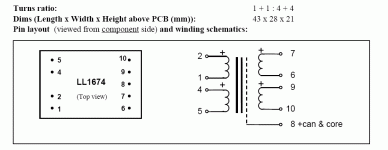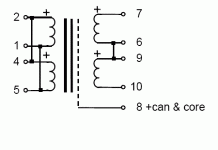AR2: They look nice and much neater than my perfboard versions. Did you post a schematic somewhere?
Here is are both schematics - regulators and buffer boards.
Attachments
Brett,
Lundahl 1674 input is connected to the modified DCX2496 output, straight from AKM4396 chip, with no caps, resistors... In the cofiguration this schematic is made for the Lundahl that is used as 1:4. If you are to use different ratio, than R106 and C108 need to be adjusted. I selected those values as Tx frequency compensation, based on the measured response on my spectral analyzer.
Also in the reg. board and on the buffer board I have shown trimmer and resistor, paralleled. The purpose is to make these boards universal, so that measurements could be done with trimmer, that is later removed and replaced with resistor. Since these are schematics used to produce boards, that why it might look confusing.
Lundahl 1674 input is connected to the modified DCX2496 output, straight from AKM4396 chip, with no caps, resistors... In the cofiguration this schematic is made for the Lundahl that is used as 1:4. If you are to use different ratio, than R106 and C108 need to be adjusted. I selected those values as Tx frequency compensation, based on the measured response on my spectral analyzer.
Also in the reg. board and on the buffer board I have shown trimmer and resistor, paralleled. The purpose is to make these boards universal, so that measurements could be done with trimmer, that is later removed and replaced with resistor. Since these are schematics used to produce boards, that why it might look confusing.
How high will the out be after the 1:4 trafo?
Rysen, I do not have it connected to the Behringer yet, but this circuit will provide, measured 22.6 dB of Voltage gain.
Vlad - repetitive mind-slip you're making is - your Lundahl xformers are connected 1:8 , not 1:4
at least looking on my sketches

Nope, nope. That transformer could only be used as 1:2 or 1:4. I have been using it as 1:2 before, and now is 1:4
Attachments
Vlada je moj drug !
B...E..N...Z..I...N

look - "1" - from datasheet : 1+1 : 4+4
and look "new wiring" ... at least I drew that ........and I hope that you connected them as drawn
only in that way we have enough gain for your needs , and we can avoid active gain stage

B...E..N...Z..I...N

look - "1" - from datasheet : 1+1 : 4+4
and look "new wiring" ... at least I drew that ........and I hope that you connected them as drawn
only in that way we have enough gain for your needs , and we can avoid active gain stage

Attachments
Last edited:
Vlada je moj drug !
B...E..N...Z..I...N
look - "1" - from datasheet : 1+1 : 4+4
and look "new wiring" ... at least I drew that ........and I hope that you connected them as drawn
only in that way we have enough gain for your needs , and we can avoid active gain stage

Yes, connected as planned. See schematic above, few posts. Measured last night, gain 22.6 dB.
Hi AR2, thanks for the schems. But I'm wondering why you want the gain from the trafos? Even at 1:1 level is about enough to drive most poweramps to clipping. It certainly has been in my testing.
Combination of amps, speakers and space require me to have more drive. In my test it just worked better this combination. Last several years, I use to drive it in 1:2 set up and it was not enough. That was without buffers. Lundahls I got at the time were what they are since I did not think that 1:1 would be enough for me.
I find that hard to believe unless you are using DIY amps with very low gain. The 4396 will give about 5.6Vpp for 0dBFS.Combination of amps, speakers and space require me to have more drive. In my test it just worked better this combination. Last several years, I use to drive it in 1:2 set up and it was not enough. That was without buffers. Lundahls I got at the time were what they are since I did not think that 1:1 would be enough for me.
Hi all!
I have a question regarding this product. Lets assume i want to use it in a biamp configuration. My speaker has a midwoofer 88db/8Ohm, and my tweeter is 93db/6Ohm (Im just writing random values).
My question is, is there any way to correct different sensitivity/resistance values to have a flat spl response?
I guess that will be the gain function, but the question is how can i calculate proper values for it?
I have a question regarding this product. Lets assume i want to use it in a biamp configuration. My speaker has a midwoofer 88db/8Ohm, and my tweeter is 93db/6Ohm (Im just writing random values).
My question is, is there any way to correct different sensitivity/resistance values to have a flat spl response?
I guess that will be the gain function, but the question is how can i calculate proper values for it?
My question is, is there any way to correct different sensitivity/resistance values to have a flat spl response?
I guess that will be the gain function, but the question is how can i calculate proper values for it?
It's dead easy. Just have the output gains set (for the example you give) 5 dB apart. That will be a good starting point- you would then do some SPL measurements to confirm or to readjust. Datasheet numbers are not always perfect...
Have you gotten the miniDSP? I'm interested in user impressions as I'm getting frustrated with DCX hiss and the hassle involved. I have seen concerns raised about poor measured s/n ratio as well as whine with them as well.
The one setups is PS3 -> OUTLAW 970 -> DCX2496 -> Outlaw amps. Its been fine for a couple of years. soon it will be replaced by the MiniDSP but I was doing comparisons and I explained that that Pro nature of the DCX had issues and one of them was the hot outputs and how they increased the hiss of my Ribbons (Easy to hear and measure that hiss diference in dB so its not subjective).
My HT setup is the Onkyo 885 -> DCX2496 -> collection of pro amps with gain controls.
Im not debating the issue of gain control at all, I fully understand the compromises that come with that issue.
Yes, I have two now. First one is being used with my 2-way ribbon designs. The second one is being tested with my LMS5400 sealed sub design. I will be using it to create a L/T circuit.
Do you have link to the poor measured s/n ratio of the MiniDSP. Mine is dead silent with my Neopro5i ribbons.
Im going to get a third minidsp in Jan 2011, gotta try 96dB slopes on my waveguide designs. Then use Trinnov optimization to solve the phase issue with steep slopes.
Do you have link to the poor measured s/n ratio of the MiniDSP. Mine is dead silent with my Neopro5i ribbons.
Im going to get a third minidsp in Jan 2011, gotta try 96dB slopes on my waveguide designs. Then use Trinnov optimization to solve the phase issue with steep slopes.
Jack's horns whine with 2 amps, 1 supply
.
If you are talking about the posts jzagaja has made about his set up with Minidsp into two, 2X100 amps, the whine is a common problem when running two class D amps from one power supply and the hiss is due to using 100db drivers/ horns with no passive attenuation. Neither issue is related to the Minidsp.Have you gotten the miniDSP? I'm interested in user impressions as I'm getting frustrated with DCX hiss and the hassle involved. I have seen concerns raised about poor measured s/n ratio as well as whine with them as well.
.
Last edited:
minidsp
Sendler-correct, that post, and I think it's the only negative one I've seen so doubt the measurements as he has gone on to post a number of other questions on the Minidsp's own forum. My problem however will be the same-ultra efficient 4 way horn system well over 100db efficient. I also am confused about how to control gain using the minidsp board- are you supposed to wire in a physical knob to control it? Is it ok to go from a Rogue tube preamp to the analog in's and still get good s/n when playing low, will that cause issues between low and high volume? I'm not an electronics guy, more of a speaker builder. Their website does not seem to clearly explain as they assume more electronics knowledge than I have.
Sendler-correct, that post, and I think it's the only negative one I've seen so doubt the measurements as he has gone on to post a number of other questions on the Minidsp's own forum. My problem however will be the same-ultra efficient 4 way horn system well over 100db efficient. I also am confused about how to control gain using the minidsp board- are you supposed to wire in a physical knob to control it? Is it ok to go from a Rogue tube preamp to the analog in's and still get good s/n when playing low, will that cause issues between low and high volume? I'm not an electronics guy, more of a speaker builder. Their website does not seem to clearly explain as they assume more electronics knowledge than I have.
- Home
- Source & Line
- Digital Line Level
- Behringer DCX2496 digital X-over

